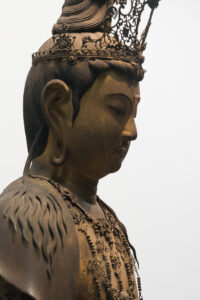In my last blog (LINK), I referred to JIZO BOSATSU (Bodhisattva of Earth) by providing several stories which include “Why an array of six JIZO BOSATSU statues?” and “Why wearing a red cap and bib?”. If I make a quick explanation to these Qs, these are based on a Buddhist theory and a folk belief, respectively; six JIZO BOSATSU are dispatched to each of the six posthumous realms in Buddhism and save any people in any circumstances in any of the six realms including those who have fallen into Buddhist’s Hell; JIZO BOSATSU is believed to be a guardian divinity who saves dead children and guides them to Buddhist’s Heaven so parents who have lost their children worship JIZO BOSATSU, presenting them with a red baby cap and bib to express their gratitude.

JIZO BOSATSU is a very popular Buddhist divinity among people but it represents just a part of the world of BOSATSU. By definition, BOSATSU or Bodhisattva is the one who is on the way of attaining enlightenment through ascetic practice of Buddhism but has already had a strong aspiration and compassion to save all living things. Let me refer to several other BOSATSU for your interest.
SHO KANNON BOSATSU

SHO KANNON BOSATSU or SHO KANNON for short is often referred to as “Goddess of Mercy” for its being compassionate for all living creatures and providing them divine helps. As you can see from the photo (above), SHO-KANNON wears a crown and accessories. This is because its prototype is believed to be a figure of Shakyamuni (the founder of Buddhism) in his early days as prince of a royal family in ancient India. Before his renunciation of secular world, he was thought to have worn such luxurious things.
KANNON & Canon
A digression which you may be interested in. Canon is a Japanese company which has a firm global presence in optical and digital camera, digital equipment such as copiers and laser printers, and semiconductor exposure device. The company name of Canon has its origin in KANNON. Their first experiment model or prototype of camera was developed in 1934 and named KWANON (equivalent to KANNON). If you go to Canon’s company homepage, you will be able to find their interesting story about how “KWANON” turned out to be “Canon”.

(from Canon’s Homepage: Engraving using the image of Kwanon attached to the “Kwanon” prototype as a motif)
https://global.canon/en/corporate/logo/
SENJU KANNON BOSATSU
The image used in Canon’s engraving is SENJU KANNON BOSATSU or SENJU KANNON for short. SENJU literally means “one thousand arms”, each of which has an eye of compassion and a tool to find and save people. With the one thousand arms, SENJU KANNON saves myriads of suffering people in any circumstances. There are SENJU KANNON which actually have one thousand arms attached but they constitute a minority. Majority of SENJU KANNON have been created with 40 arms with a Buddhist theory that each arm is to be responsible for 25 different roles (40 x 25 = 1,000!)

If you pay attention to the upper part of the head on the photo above, you will notice small heads. This statue represents a variation of SENJU KANNON BOSATSU: “JU-ICHI-MEN” SENJU KANNON BOSATSU with eleven small heads (or, JU-ICHI-MEN). By the eleven heads, this BOSATSU is able to look around 360 degrees to detect suffering people in any direction. It seems that this BOSATSU is a perfectionist, avoiding any overlooking with the eleven heads in addition to the 40 arms.
MIROKU BOSATSU

MIROKU BOSATSU is considered “Bodhisattva (BOSATSU) of the Present” and “Buddha (NYORAI) of the Future”. Buddha or NYORAI is one who has attained enlightenment which is the final goal of Buddhism. After ascetic training for a long period, MIROKU BOSATSU is to appear in this world as MIROKU NYORAI. The photo above is “HANKA SHI-YUI” MIROKU BOSATSU; “HANKA” and “SHI-YUI” mean “the half-lotus position” (putting the right foot on the left thigh) and “contemplating” things like how to save people, respectively.
Besides BOSATSU referred to above, there are other distinctive BOSATSU, each of which has its own venerability. Please just allow me to put just a few words for each of them for the sake of space and time.
NYOI-RIN KANNON Bosatsu, for helping your desires get fulfilled
FUGEN Bosatsu, for protecting Buddhist monks in acetic training
MONJU Bosatsu, for managing wisdom
KOKUZO Bosatsu, for controlling memory
I wish you be able to visit Japan before long with COVID-19 put under control and enjoy the world of BOSATSU and other types of BUTSUZO (the Buddhist statues)!
By Jin Shibata

Comment